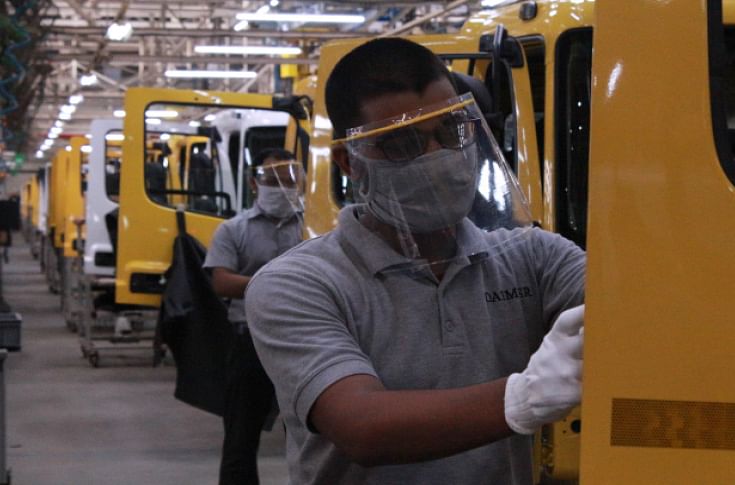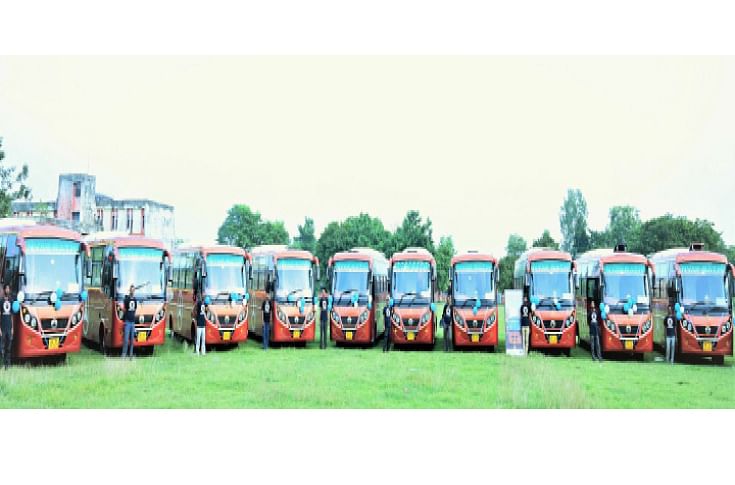Daimler leverages Covid lessons for India truck business
Satyakam Arya, Managing Director and CEO of Daimler India Commercial Vehicles explains how the pandemic has helped the company improve its costing structure while focusing more aggressively on digitalisation.
Satyakam Arya cites the popular acronym VUCA (volatility, uncertainty, complexity and ambiguity), now “at its peak” in today’s times, to drive home an important message. “Planning has become more complex and you need to take many more variables into account,” says the Managing Director and CEO of Daimler India Commercial Vehicles (DICV), the maker of the BharatBenz brand of trucks and buses.
The conversation is happening over breakfast on a wet monsoon morning in Mumbai. Arya knows only too well that these are challenging times for the world thanks largely to the pandemic but insists that “whatever system you deploy is fine but eventually I believe you need to follow your gut instinct”.
This, in turn, is possible if one has an “overall grip of the situation” and knows how the world is reacting. “With something like Covid, you could still go wrong by 15 percent compared to five percent for instance in the past. Should you therefore get bogged down by this reality? Not at all!’ he reiterates.
On the contrary, “you should learn to live with it and better yourself” while changing the pace within the organisation. It is here that planning also becomes critical in an industry like automotive characterised by its long and deep supply chains across geographies with “different phenomena happening all the time”.
Take the case of the global semiconductor crisis which has been making news almost every day. As Arya says, this is an issue which affects everyone and will remain a challenge for at least a year longer. Chips have a long supply chain till they finally get into the engine control unit. Companies like DICV also use electronic parts and this is where real time risk tracking becomes very important.
“We do not have a visibility beyond a certain period,” he says while emphasising that other crises in the past could be handled within a relatively shorter period of 15 days or three months at the outer limit. This time around, it is a challenge for truck makers because it is about balancing across different product lines though the comforting part about commercial vehicles (unlike cars) is that there are not too many models. Line-ups are also more standardised with the exception of customised orders.
The other challenge for automakers relates to the high cost of containers since supplies are limited. Simply put, if a company needs 500 a month and can get access only to 300 containers, it must pay more at spot rate for the balance 200.
In an ideal environment, filled containers are sent to their destinations where they are emptied out and then get back to the supply pool. However, with Covid, this chain gets broken “again and again”. For instance, if there are high infections in an importing country, the containers reaching there are not emptied immediately since people are not at work.
“The supply chain and availability are getting disrupted while lockdowns worsen the situation especially if the country is an active exporter/participant in global trade,” explains Arya. This is true for DICV which has a substantial basket of exports though “thankfully" there is a department globally for Daimler to handle this. Yet, it does not take away the fact that greater advance planning is imperative for containers worldwide including in Chennai where the Indian arm has its operations.
From the CEO’s point of view, the key is to constantly find solutions during a crisis. During Covid, the company supported suppliers through availability of raw material like steel while working with them through the oxygen crisis to look at alternative ways of welding.
“I see this pandemic as challenging us to improve our business . . . our cost structure has become leaner and we have done a lot of digitalisation and more is in progress. This has helped us become more flexible and agile,” says Arya.
Cost control, a learning from the pandemic
As he puts it, DICV learnt valuable lessons from the first wave and when the market was back to posting good volumes in June this year, it was running two shifts “smoothly at the plant” with adequate stocks at dealerships. “This is how the crisis has helped us in terms of our costs getting better — we have become very fast and are now continuing to progress on digitalisation,” he adds.
This is particularly important when there are supply chain challenges to contend with for the next 12 to 18 months. The need of the hour is greater visibility into the entire supply chain to plan out better for the future.
“You need to do real time risk management and this can be done with a digital supply chain,” says Arya. In the past, this was carried out with Tier 1 suppliers but people are now even going to Tier 3 “where it is needed”. This is the best way to access the entire supply chain digitally and “you can do real time risk planning since you are ahead in solving problems”.
Likewise on the market side, the focus is getting more digital too right from buying a vehicle or component. For truck buyers, this unlocks a lot of efficiencies and vehicles are now connected to the fleet owners. “This opens a wide range of possibilities like tracking a vehicle live in your room on a giant screen,” says Arya.
This is live time where alerts come in if a driver were to deviate his vehicle from the set route. It is also easier to track braking, check if fuel was stolen, real time fuel consumption. All this gives a better idea of how the fleet is doing along with individual driving patterns. “We can do predictive maintenance and find out if the truck was overloaded,” he adds.

Engine overrun is common in the CV industry which affects its life and therefore reinforces the need for driver training. “But now, you can target the specific fleet and driver . . . sitting in my office I can see BharatBenz trucks and check out the regions where engine overruns keep happening,” explains Arya.
All these checks will ensure that fleet utilisation and efficiency levels improve which is good for owners since it will mean a reduction in logistics costs and increase profitability. Hopefully, it will also induce them into buying more trucks.”We need to work with stakeholders constantly and bring technology for market needs,” he says.
Transition and transformation
DICV recently hired a Chief Operating Officer and also created a new position of Chief Transformation Officer (CTO). Arya says these changes reflect what the entire auto industry is going through in terms of a major transformation across technology, markets, products etc.
“To me, this is a once-in-a lifetime opportunity and every CEO needs to spend more time enabling that transition,” he says. It is for this reason that a COO is needed to be more hands on across operations while the CEI focuses more on transformation even while they work together.
Likewise, the CTO has been entrusted with the task of preparing the company and its employees for the future. Changes will happen where the focus is carbon neutrality. This is the biggest part of the transformation along with digitalisation and connectivity, adds Arya.
“The business model of a fleet owner will be completely digital and a software enabled ecosystem will be the name of the game. You also need to be prepared for culture change where you need to work with partners and become more innovative,” he says.
There is a need to “embrace some ways” of start-ups and this is why people should think of new ideas and push the envelope in creativity. It is the CTO who needs to make these things happen even while the BharatBenz academy with different schools under its umbrella will focus on innovative technology like digitalisation and electric mobility to train its workforce.

On August 24, DICV delivered 20 BharatBenz 1017 buses through its dealer partner Gautam Trucking in Begusarai, one of the primary bus hubs in Bihar. The delivery indicates signs of recovery of the bus segment in the East.
As for the CV business, Arya believes that the economic recovery has been “quick and strong” after the second wave which is evident from monthly sales numbers. After the first wave, there was a lag of nearly two quarters before “some sort of recovery” began happening.
This time around, it has happened faster where the first seven months of calendar 2021 (January-July) saw medium and heavy truck volumes surpass the figure of 106,000 units in 2020. The same buoyancy has been seen in lighter trucks thanks to the e-commerce boom which has spurred online buying.
Going by the current momentum, the year could end with the 10-55 tonne category registering numbers of nearly 205,000 units which will be twice the levels of 2020 though still below normal industry volumes of 250,000 to 300,000 units. This may well happen in 2022 which augurs well for the medium and heavy truck space.
“There is uncertainty about the third wave but the present rate of vaccinations will help check this and make it muted. I don't see too much risk as a result. Covid is also emerging as a regional phenomenon and we must learn to live with it,” says Arya.
States which are aggressive on vaccination will see a faster economic rebound though the fact remains that even those with higher infection rates are still doing well in terms of truck sales momentum. “However if they don't vaccinate quickly enough they will face the threat of a stronger third wave,” he warns, which could mean more hospitalisations and casualties.
Right now, there is strong growth from the construction segment while last mile e-commerce distribution is doing well which is good for BharatBenz trucks which “can drive longer periods at high speeds with no breakdowns’. Good recovery is also being seen in long haul trucks thanks to steel and cement picking up.
“There are challenges however in terms of commodity prices and the supply chain which will take time to settle down,” says Arya. According to him, the rebound could be a result of people having been through a rough time with Covid and are keen on restarting their businesses. There is also more disposable income in their hands going by the savings lying in bank accounts of people in Europe and the US amounting to $5.6 trillion.
This was thanks to the direct subsidies provided by their governments and a whole lot of people did not spend the money but chose to keep it for a rainy day. In India too, savings are 16 percent more than it used to be pre-Covid even while taking into account the reality that its citizens were hit by the pandemic.
“Overall, the picture is not so bad. We were concerned by Covid hitting the rural market but this has not happened because of the resilience of people,” says Arya who believes that things are finally back on track after four years of a slowdown and the pandemic. “I also think that the next 4-5 years will be great for the CV industry,” signs off DICV's chief.
This feature was first published in Autocar Professional's October 1 issue.
RELATED ARTICLES
Renault India's Quiet Fixer
As the head of Renault India, Francisco Hidalgo Marques faces his biggest challenge yet.
Tesla’s Test
Unlike in other markets, Tesla has taken a long-game approach in India, focusing on creating the infrastructure first.
‘India’s E20 Strategy Is the Template Europe Now Needs’
Mahle CEO Arnd Franz believes India’s flex-fuel shift is proving more resilient and market-aligned than the EU’s all-ele...






 01 Oct 2021
01 Oct 2021
 7880 Views
7880 Views





 Ketan Thakkar
Ketan Thakkar




